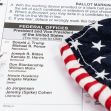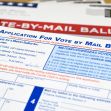One would struggle to argue that 2020's presidential election is a normal one for the United States. Between the coronavirus pandemic and racial unrest, this year is undoubtedly historic. It is worth remembering that even in our relatively short national history, the American people have weathered other unusual and even chaotic events during presidential elections. The devastating Spanish Flu and even the Civil War did not prevent elections from occurring. The fact that Americans went out to cast their ballots while two halves of the country were literally in the midst of a bloody battle for the nation's future may appear to make elections and their timeliness an almost sacred tradition. But what does the Constitution say about the timing of elections? And could mail-in ballots cause impermissible delays in election results?
Election Rules in the Constitution
The Constitution does not state the requirements for the election's date. Nor is there information contained in the Constitution regarding the deadline for the submission of Electoral College votes. The only date within the Constitution is January 20th when the Presidency must pass from the former Commander in Chief to the newly elected official. As long as the election process is complete by the January 20th transfer of power, the Constitution's terms are satisfied.
Laws Create Other Voting Requirements
The Constitution delegates the power to choose the timing of the election to Congress. Legislators set the date by which the states must select Electors and the date by which those Electors must cast their votes. In 1845, Congress enacted a law that determined that the Election Day will be uniformly held throughout the country in November on the Tuesday following the first Monday of the month. Congress must receive the Electoral College votes by the fourth Wednesday in December.
Because the power to schedule elections rests with Congress, the legislative branch could decide to move the election date, but doing so would require that the House and the Senate agree. The current Democratic majority in the House and the Republican majority in the Senate make such an agreement unlikely.
Postponing an election would also create problems because Congress cannot change the date at which the President's term comes to an end. Even if the nation did not hold an election, the President's term would end on January 20th of the year following the election year. The President cannot continue to hold office following January 20th without violating the 20th Amendment. A national emergency will not change the end of the President's term. It is important to note that the Vice-President's term also must come to an end on that same day.
The lack of an election, according to some legal scholars, would trigger the rules of succession. As a result, once the President and Vice-President ended their terms, the Speaker of the House would become President. If correct, this theory means that if no election occurred this year, we would see a President Nancy Pelosi take office on January 20th, 2021. Although, with Pelosi's term also coming to an end in December of 2020, Chuck Grassley, the 86-year-old Senator from Iowa and current Senate president pro tem, would be next in line. Even that scenario is flawed as one-third of the Senate's seats also expire, which leaves a question about whether the Republicans would still maintain a majority in the Senate. A loss of the majority would mean that Senator Grassley would cease to serve as pro tem.
Clearly, the rules could lead to a confusing situation that, hopefully, America will avoid.
Will Mail-In Ballots Violate the Legal Timeline for Electing the President?
The Trump Administration is attacking mail-in voting as fraudulent, which is causing concerns throughout the nation. This election will likely result in record numbers of mail-in votes because of fears over the coronavirus. In Pennsylvania, an important swing state, officials anticipate ten times as many mail-in voters in 2020 compared to 2016. Registered Republicans are far less likely to request a mail-in ballot than are Democrats. In fact, Democrats are voting by mail at a rate of three for every one mail-in ballot from a Republican. In an election year where even using a mask to prevent the spread of a deadly disease has been politicized, the reason Democrats are more inclined to request mail-in ballots is fairly obvious. President Trump has repeatedly downplayed the virus and encouraged his followers to continue going about their business amid the pandemic. Democratic leaders are advising more caution, which is prompting more left-leaning voters to request mail-in ballots rather than going in-person to crowded polling locations.
Processing mail-in ballots takes time. Some election officials believe that the time necessary to check the authenticity of ballots will be used to question the validity of those votes. In reality, the time needed to process the ballots is essential because of the careful vetting officials engage in to prevent acts of fraud.
In Georgia, the anticipated larger number of mail-in votes led the election board to implement a rule permitting the processing of mail-in ballots fifteen days before Election Day as a way to reduce the burden on officials on November 3rd. Not every state is permitting such measures, though, and there could, therefore, be delays in election results.
Some anticipate that President Trump will see the numbers of votes in his favor surge on November 3rd, only to have Vice
President Biden gain the majority once the mail-in votes are counted. Such a scenario is likely to cause a great deal of friction and could result in legal battles.
Although the mail-in ballots could lead to delayed results in completing the election, the Electoral College votes are only required to be completed by late December. Taking an extra month or so to count the mail-in ballots in no way violates the Constitution or other election laws.
Mail-In Ballots May Come in After Election Day
States determine the deadlines for voting by mail. Some states require that voters post their ballots by November 3rd, while others require that the election board receive the ballots by November 3rd. The rules vary a great deal, so voters must check the information for voting in their states. In California, for example, ballots postmarked by November 3rd at the latest are valid so long as the county elections office receives that ballot within seventeen days of the election. Postmarked ballots arriving after Election Day will add to the time needed to reach a result. Still, it is unlikely that the delays would be long enough to violate the December deadline for Electoral College votes.
While mail-in ballots and election results that come in after November 3rd are both permitted under the Constitution, the legitimacy of the results could come into question. Some experts expressed concern over whether the election results will meet a challenge, even before COVID-19 created an unprecedented and complex scenario. America's political climate is so hyperpolarized that a person's views on medical advice and the Post Office are likely linked to their pick for the next President.
Any perceived discrepancy in voting results could lead to scrutiny and turmoil.
Although we can hope that the election will lead to a smooth transition into the next four years, in 2020, one could be forgiven for a certain level of pessimism.






